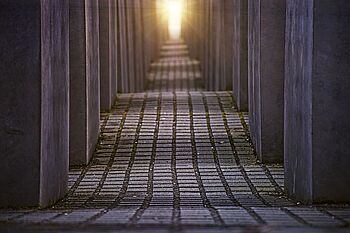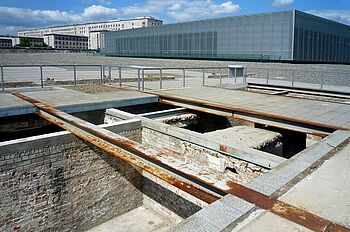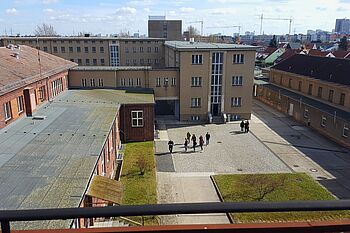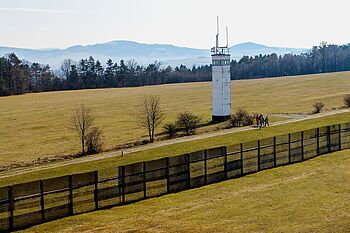The Nazi and Communist dictatorships are documented at many memorial sites in Germany. Most of these memorials are located at historical sites, such as here at the Berlin Wall. Immediately following World War II, little attention was paid to former concentration camps and other sites of persecution. Beginning in the 1960s, however, more and more memorial sites were created, a trend that continued after the GDR came to an end. Today, even experts have difficulty keeping track of the huge number of memorial sites in Germany.
Memorial to the Murdered Jews of Europe

The sunlight flashing through the long passageways of the Berlin Holocaust Memorial could be understood as a symbol of hope. But the Memorial to the Murdered Jews of Europe, as it is officially called, was erected to commemorate a unique crime: the murder of more than six million Jews, mostly through industrial methods, on orders from the Nazi leaders in Germany.
The Holocaust Memorial, which officially opened in 2005, is located in Berlin on the former border strip of the GDR, not far from the Brandenburg Gate. It consists of more than 2,700 rectangular concrete columns (stelae) arranged in a grid pattern over an area of 19,000 square meters. Changing perspectives are created by the stones’ varying heights ranging from zero to four meters and by the undulating surface on which they are positioned. The labyrinth-like monument was designed by the New York architect Peter Eisenman, who wanted his design to convey the incomprehensibility of the Holocaust.
An underground Information Center beneath the monument contains an 800-square-meter exhibition on the history of the Holocaust, two lecture rooms and a bookstore. At computer stations, visitors can research the database of the Israeli Yad Vashem Memorial, which contains the names of almost four million Jewish victims. The memorial receives 480,000 visitors annually (2019), making it one of the ten most frequently visited museums in Berlin.
The memorial was initiated by the publicist Lea Rosh and the historian Eberhard Jäckel. Two design competitions were held, one in 1994 and another in 1997. In 1999, the German Bundestag decided to build a modified design created by Eisenman that included an underground exhibition space. A foundation was established to oversee construction and operate the site. The federal government provided 27.6 million euros for the monument’s construction, half of which went towards building the “Field of Stelae.” The remaining funds were used for the Information Site. The land was valued at 40 million euros. Almost one million euros in donations were raised. The foundation, which is funded 100 percent by the German government, had a budget of 3.2 million euros in 2017. It is also responsible for overseeing three other memorials that were later erected to commemorate the murdered Sinti and Roma, the victims of “euthanasia” killings, and homosexuals persecuted under National Socialism.
Links
Website of the Foundation for the Memorial to the Murdered Jews of Europe
Report from the Foundation for the Memorial to the Murdered Jews of Europe, 2006 to 2008 (German)
Report from the Foundation for the Memorial to the Murdered Jews of Europe, 2009 to 2011 (German)
After the Dictatorship. Instruments of Transitional Justice in Former Authoritarian Systems – An International Comparison
A project at the Department of Modern History at the University of Würzburg
Twitter: @afterdictatorship
Instagram: After the dictatorship
With financial support from the German Federal Ministry for Economic Cooperation and Development
Topography of Terror

A documentation center built on the foundations of the former headquarters of the Secret State Police (Gestapo) provides information about persecution under the Nazis. With almost 1.3 million visitors annually (2019), it is one of the most popular sites of remembrance in Berlin.
The 4.5 hectare of exhibition space is located on the grounds that once housed the most important institutions of the Nazi terror apparatus: the Secret State Police in the former School of Arts and Crafts, the Reich SS Leadership in the former Hotel “Prinz Albrecht” and the Security Service (SD) of the SS in the neighboring Prinz-Albrecht-Palais. The newly founded Reich Security Main Office moved into this palace in 1939 as well.
The buildings were severely damaged during World War II and the ruins were demolished and cleared away in the 1950s. Only the cellars were partially preserved, including the foundation remains of cells in the Gestapo’s “house prison.” When the Berlin Wall was built in 1961, this area that had previously been situated in the middle of Berlin found itself on the periphery of the city’s western half. A track was set up where people could practice driving and a company established a dump site for debris. The area was first opened to the public in 1987 as part of Berlin's 750th anniversary celebration. A section of the cellar remains was exposed and a temporary exhibition opened in the pavilion.
In 1992, two years after the GDR joined the Federal Republic, the “Topography of Terror,” a state-funded foundation, was established. After two architectural competitions and a long construction period, the Documentation Center opened on the redesigned grounds in 2010. An 800-square-meter permanent exhibition is presented in the exhibition hall, providing information about the activities of the Gestapo, SS and Reich Security Main Office. An open-air exhibition titled “Berlin 1933-1945: Between Propaganda and Terror” is presented on the outdoor grounds. Visitors can also take a tour of the grounds, which includes explanations at 15 stations. The tour passes by a section of the Berlin Wall which was built on the border to the grounds in 1961 and which is now a preserved historical monument.
Links
Website of the Topography of Terror Foundation
Interview with the long-time director of the Topography of Terror Foundation (German)
German federal government’s website on places of remembrance in Germany
List of Third Reich memorial sites in Berlin
Interactive map of places of remembrance on Nazi crimes (partly German)
Website with information on additional memorial sites dealing with the Nazi era (German)
Berlin-Hohenschönhausen Memorial

Credit: Hubertus Knabe
The central remand prison of the GDR Ministry for State Security is almost completely unchanged. Each year, some 450,000 people visit this oppressive site in the Berlin district of Hohenschönhausen. In 1992, the approximately 170 cells and 120 interrogation rooms were listed as historical monuments.
More than 40,000 people were imprisoned in Hohenschönhausen from 1945 to 1990. The Soviet secret police set up Special Camp No. 3 at the site in 1945. In 1947 it became the central remand prison of the Soviet State Security Service for Germany. The prison was taken over by the East German secret police in 1951. Ten years later, a new, larger prison and prison hospital were built. For many years, the State Security Service also operated a labor camp in addition to the prison.
Following the Peaceful Revolution of 1989, all political prisoners were released. The prison was closed when Germany was reunited. On the initiative of former prisoners, a memorial was erected at the site in 1994. Since 2000 it has been managed by a foundation under public law. The visitor reception area, café, bookstore, seminar rooms and a 400-square-meter permanent exhibition were integrated into the complex without causing significant changes to its appearance. The original outdoor area, which includes a high prison wall, watchtowers and alarm wires, has been entirely preserved, as have the prison corridors, cells and interrogation rooms on the inside. Until recently, guided tours of the buildings were conducted mostly by former prisoners.
Point Alpha Memorial

Credit: Tilmann2007
Until 1990, the GDR border cut through the middle of Germany over a length of almost 1400 kilometers. Very little of the massive fortifications has been preserved. The largest memorial site commemorating German division is located between the states of Hesse and Thuringia. This is where the U.S Army’s observation post "Point Alpha" was located.
If there had been a Third World War between NATO and the Warsaw Pact, it probably would have started here. In an escalation of events, the West expected Soviet troops to advance near the city of Fulda in Hesse. The territory of the GDR extended far into the Federal Republic here and there were few natural obstacles. This area, known as the Fulda gap, was considered a “wasp’s waist” because an advance of eastern tanks would have separated the northern and southern NATO army groups. More than 150,000 soldiers and about 4,000 battle tanks and other armored vehicles faced each other here.
The U.S. observation post “Point Alpha” was situated on a 400-meter-high mountain on the West German side. This point offered a view far into the territory of the GDR. The Federal Republic had given the site to the U.S. Army in 1965. In 1968, it erected an observation tower, first of wood, later of steel and finally, in 1985, of concrete. The site was abandoned after German reunification, and was listed as a historical monument in 1995. A memorial began its work here three years later. A section of the eastern border strip was added to the memorial at a later date.
Today, the memorial site includes three barracks on the western side, a motor vehicle hall and an observation tower from the former U.S. base. On the eastern side, the memorial includes a reconstructed GDR border facility and an art installation. The “House on the Border,” which contains a permanent exhibition, was built on the former patrol road of the GDR border troops. A former observation tower of the GDR border troops is also open to visitors. Almost 100,000 visitors come to the memorial each year. It is run by the Point Alpha Foundation, founded in 2008, which also operates an educational academy.